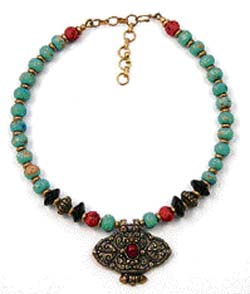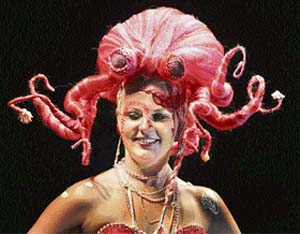|
fashioN
Jewellery for all occasions
When you are in office you do not want much attention to the jewellery you wear. Whereas when going for a sangeet function or a wedding, you need traditional designs, writes
Dhanvanti Keshavrao
 Fashions change so fast that it is said that by the time you reach home with the jewellery packet from the shop, the trend would have changed. Of course the fairer sex is responsible for this. For example, if you ask working women, they will say that the light-weight jewellery is the fashion as they would not look out of place in offices, and jewellers stock this speciality in contemporary designs. But then ask the same women after some time and they will swear by chunky jewellery, that is traditional and heavy. This has ensured that there is market for both the varieties and we often have antique jewellery with a modern light twist. Fashions change so fast that it is said that by the time you reach home with the jewellery packet from the shop, the trend would have changed. Of course the fairer sex is responsible for this. For example, if you ask working women, they will say that the light-weight jewellery is the fashion as they would not look out of place in offices, and jewellers stock this speciality in contemporary designs. But then ask the same women after some time and they will swear by chunky jewellery, that is traditional and heavy. This has ensured that there is market for both the varieties and we often have antique jewellery with a modern light twist.The essential element was that the antique flavours should not be lost. Further, the trends in jewellery invariably resonate with the personality of women. When you are in office you do not want much attention to the jewellery you wear. Whereas going for a sangeet or wedding, traditional designs are sought after. In both cases garish jewellery is shunned. The emphasis is on muted shades with mature colours like deep maroons, pinks and greens. Ancient art and modern aesthetics mingle well at jewellers’ shops in India. Goldsmiths delve into India’s storehouse of traditional art and use ancient skills in unique formats and concepts in a contemporary genre. The vast variety will leave you delirious. Fashionably shaped funky gold is among the most popular material for delicate ornaments all over India. It is chased, engraved, filigreed or granulated, giving birth to a wide array of ornaments in different textures, finish and styles. Jewellers in different parts of India have their own antique designs to draw upon. The designers in the Kashmir valley reflect the local flora in their design. Their long chained earrings are typical to the Kashmiri women. In the hilly tracts of the misty Himachal countryside they inlay it with precious stones. Rajasthan is known for its rich chunky silver jewellery as is its neighbour Gujarat. Earrings, bracelets, heavy pendants in animal motifs, waistbands and anklets are produced in different ways according to local villages in the region. Local jewellers in the North use the mango motif and use tiny bells to embellish anklets, bundles and necklaces. These are sometimes fashioned into magic amulets to ward off evil. These are used in dargahs by Muslim holy men who tie one of these around your neck or arm to help you achieve what your heart
desires

A model shows off her hair during the recent Imperia Vodka Hair competition in Manchester. Photo: AP/PTI |
In Bengal nakchhabi, a nose ornament, was also much in fashion in the good old golden days. Nakchhabis went out of fashion but have made a token return in the form of a tiny precious stone set in gold or a plain gold stud fixed on the outer lobe of the left nostril. Similary, kanbala and jhumkas have given place to modern makri, a simple hoop for the ears, which is very popular with young girls. In south India it is kaasu malai (chain of coins) that is symbolic of the era when gold was a mere two rupees a gram. In olden days, an average kaasu malai consisted of 100 half sovereign gold coins, with different mounts—-parrots, peacocks or mangoes. Together with the mounts, a muzhu kaasu malai had 100 sovereigns of gold. Today it is replicated with silver coins plated with gold. In addition to these traditional designs that are being revived, many branded jewellers have turned to old type of Victorian jewellery and the temple jewellery of India. It is also realised that these antique designs can be miniaturised to an extent. Tanishq jewellers, for example, in their collection, Colours of Royalty, draw liberally from the Victorian era. While young women prefer contemporary jewellery, they also keep enquiring about designs based on temple jewellery. Naturally the shopkeeper tries to satisfy this desire by stocking temple jewellery with some contemporary elements.
— MF

|